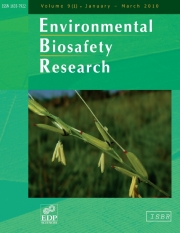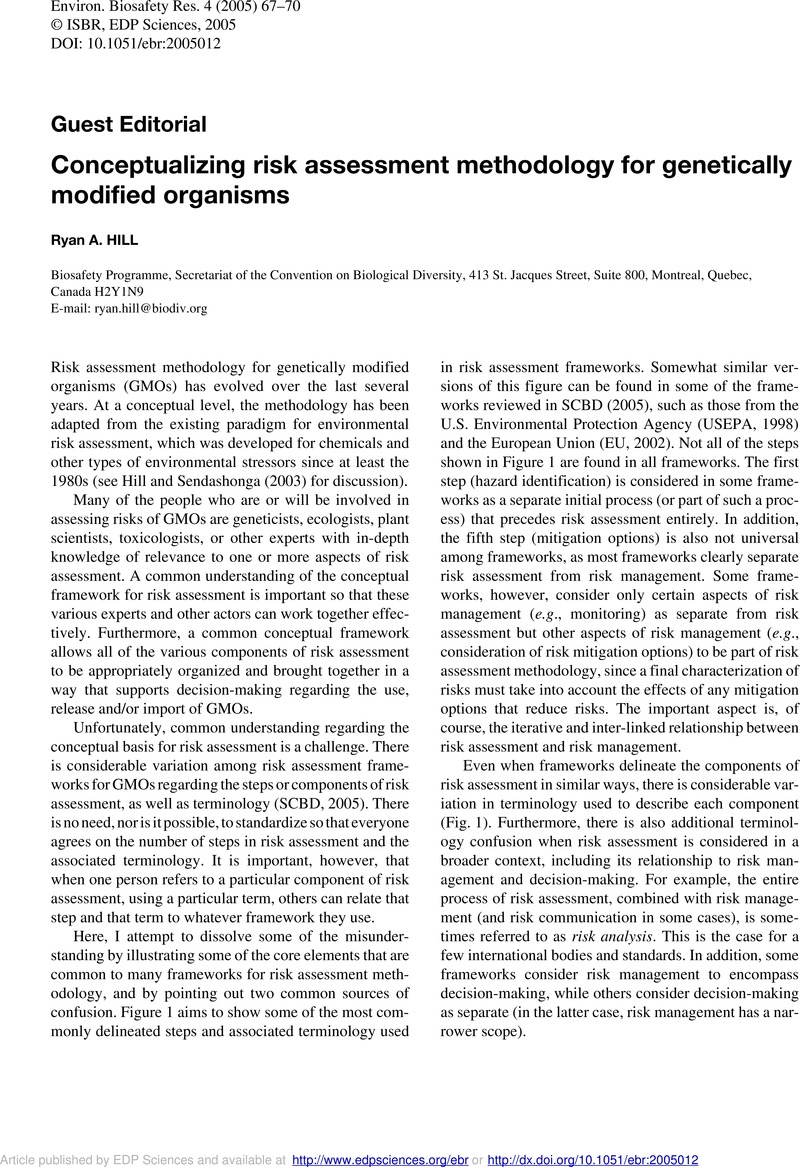Crossref Citations
This article has been cited by the following publications. This list is generated based on data provided by Crossref.
Devos, Yann
Reheul, Dirk
De Waele, Danny
and
Van Speybroeck, Linda
2006.
The interplay between societal concerns and the regulatory frame on GM crops in the European Union.
Environmental Biosafety Research,
Vol. 5,
Issue. 3,
p.
127.
Brunner, Amy M.
Li, Jingyi
DiFazio, Stephen P.
Shevchenko, Olga
Montgomery, Brooke E.
Mohamed, Rozi
Wei, Hao
Ma, Cathleen
Elias, Ani Anna
VanWormer, Katherine
and
Strauss, Steven H.
2007.
Genetic containment of forest plantations.
Tree Genetics & Genomes,
Vol. 3,
Issue. 2,
p.
75.
Griffiths, Bryan S.
Heckmann, Lars‐Henrik
Caul, Sandra
Thompson, Jacqueline
Scrimgeour, Charlie
and
Krogh, Paul Henning
2007.
Varietal effects of eight paired lines of transgenic Bt maize and near‐isogenic non‐Bt maize on soil microbial and nematode community structure.
Plant Biotechnology Journal,
Vol. 5,
Issue. 1,
p.
60.
Hills, Melissa J.
Hall, Linda
Arnison, Paul G.
and
Good, Allen G.
2007.
Genetic use restriction technologies (GURTs): strategies to impede transgene movement.
Trends in Plant Science,
Vol. 12,
Issue. 4,
p.
177.
2008.
Journal of Plant Biotechnology will be revolved toward the most rapid publication in the world plant science community in 2008: from submission to publication within two weeks.
Journal of Plant Biotechnology,
Vol. 35,
Issue. 1,
p.
1.
Murdock, Larry L.
Coulibaly, Ousmane
Higgins, T.J.V.
Huesing, Joseph E.
Ishiyaku, Mohammad
and
Sithole‐Niang, Idah
2008.
Compendium of Transgenic Crop Plants.
p.
23.
2008.
Risk assessment and variety registration of transgenic crops.
Journal of Plant Biotechnology,
Vol. 35,
Issue. 1,
p.
13.
Keese, Paul
2008.
Risks from GMOs due to Horizontal Gene Transfer.
Environmental Biosafety Research,
Vol. 7,
Issue. 3,
p.
123.
Paoletti, Claudia
Flamm, Eric
Yan, William
Meek, Sue
Renckens, Suzy
Fellous, Marc
and
Kuiper, Harry
2008.
GMO risk assessment around the world: Some examples.
Trends in Food Science & Technology,
Vol. 19,
Issue. ,
p.
S70.
Nelson, Kristen C.
Andow, David A.
and
Banker, Michael J.
2009.
Problem Formulation and Option Assessment (PFOA) Linking Governance and Environmental Risk Assessment for Technologies: A Methodology for Problem Analysis of Nanotechnologies and Genetically Engineered Organisms.
Journal of Law, Medicine & Ethics,
Vol. 37,
Issue. 4,
p.
732.
Ricroch, Agnès
and
Jésus, Franck
2009.
Consultations of stakeholders on the roles of research in relation to genetically modified plants in France.
Public Understanding of Science,
Vol. 18,
Issue. 1,
p.
91.
Yang, Jun
Wang, Zhi-Rui
Yang, De-Li
Yang, Qing
Yan, Jun
and
He, Ming-Feng
2009.
Ecological risk assessment of genetically modified crops based on cellular automata modeling.
Biotechnology Advances,
Vol. 27,
Issue. 6,
p.
1132.
Showalter, Ann M.
Heuberger, Shannon
Tabashnik, Bruce E.
and
Carrière, Yves
2009.
A Primer for Using Transgenic Insecticidal Cotton in Developing Countries.
Journal of Insect Science,
Vol. 9,
Issue. 22,
p.
1.
Myhr, Anne Ingeborg
2010.
The Challenge of Scientific Uncertainty and Disunity in Risk Assessment and Management of GM Crops.
Environmental Values,
Vol. 19,
Issue. 1,
p.
7.
Wolt, Jeffrey D.
Keese, Paul
Raybould, Alan
Fitzpatrick, Julie W.
Burachik, Moisés
Gray, Alan
Olin, Stephen S.
Schiemann, Joachim
Sears, Mark
and
Wu, Felicia
2010.
Problem formulation in the environmental risk assessment for genetically modified plants.
Transgenic Research,
Vol. 19,
Issue. 3,
p.
425.
2010.
Scientific Opinion on the assessment of potential impacts of genetically modified plants on non-target organisms.
EFSA Journal,
Vol. 8,
Issue. 11,
p.
1877.
Devos, Yann
Lheureux, Karine
and
Schiemann, Joachim
2010.
Genetic Modification of Plants.
Vol. 64,
Issue. ,
p.
553.
Prakash, Dhan
Verma, Sonika
Bhatia, Ranjana
and
Tiwary, B. N.
2011.
Risks and Precautions of Genetically Modified Organisms.
ISRN Ecology,
Vol. 2011,
Issue. ,
p.
1.
Meyer, Hartmut
2011.
Systemic risks of genetically modified crops: the need for new approaches to risk assessment.
Environmental Sciences Europe,
Vol. 23,
Issue. 1,
Mayerhofer, Marion
Mayerhofer, Reinhold
Topinka, Deborah
Christianson, Jed
and
Good, Allen G
2011.
Introgression potential between safflower (Carthamus tinctorius) and wild relatives of the genus Carthamus.
BMC Plant Biology,
Vol. 11,
Issue. 1,



